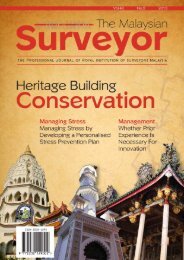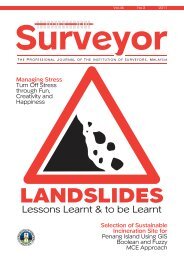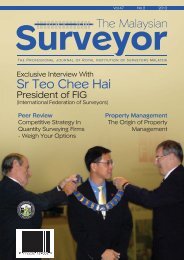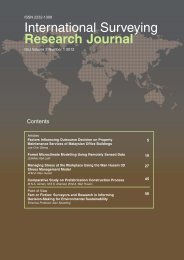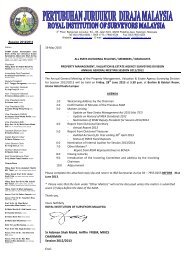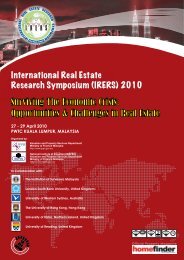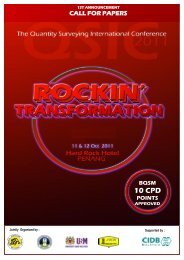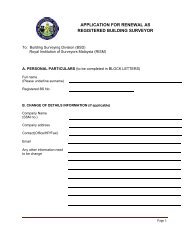Full 46.1 - Royal Institution of Surveyors Malaysia
Full 46.1 - Royal Institution of Surveyors Malaysia
Full 46.1 - Royal Institution of Surveyors Malaysia
You also want an ePaper? Increase the reach of your titles
YUMPU automatically turns print PDFs into web optimized ePapers that Google loves.
THE MALAYSIAN SURVEYOR | Vol.46 | No.1 | 2011<br />
1.0 Introduction<br />
Building condition survey is<br />
part and parcel <strong>of</strong> a wide spectrum in<br />
the building surveying pr<strong>of</strong>ession.<br />
Traditionally, building condition survey<br />
is carried out using a qualitative approach,<br />
particularly descriptive method <strong>of</strong> assessment.<br />
Most <strong>of</strong> the time, the quantitative is rarely<br />
adopted or not at all. However, this is not<br />
intended to restrict the condition survey work<br />
under the traditional method. Although the<br />
traditional descriptive forms essential<br />
information for the condition assessment <strong>of</strong><br />
one particular building as a whole. The<br />
valuable information provided can not be<br />
questioned.<br />
The aim <strong>of</strong> suggesting quantitative approach<br />
in dealing with condition survey is actually not<br />
a new paradigm. The work <strong>of</strong> Pitt (1997) and<br />
Alani et al. (2001) suggests that the ranking<br />
system should be adopted, as one means to<br />
prioritise the defects in the building (Hollis,<br />
2000). It forms supportive documentation as<br />
well as essential information, apart from<br />
traditional reporting for condition surveys.<br />
Listing defects in terms <strong>of</strong> priority provides the<br />
surveyor with a quick-reference and an idea <strong>of</strong><br />
the most severe or serious defects.<br />
Theoretically, the data in numeric form is<br />
classified as hard and reliable, thus providing<br />
tangible results <strong>of</strong> the building condition<br />
survey (Hollis, 2000).<br />
This paper focuses on developing prioritised<br />
ranking system for timber defects based on a<br />
quantitative approach. Ahmad B. R. et al.<br />
(2006) suggests that the primary causes <strong>of</strong><br />
timber defects fall within two categories,<br />
namely insects attack and fungal infestation.<br />
The element <strong>of</strong> defects diagnosis has to deal<br />
The work <strong>of</strong> Pitt<br />
(1997) and Alani et<br />
al. (2001) suggests<br />
that the ranking<br />
system should be<br />
adopted, as one<br />
means to prioritise<br />
the defects in the<br />
building (Hollis,<br />
2000).<br />
with either one <strong>of</strong> these main causes, followed<br />
by sub-causes which will be elaborated further in<br />
this paper. The explanation <strong>of</strong> prioritise ranking<br />
system starts with the formatting <strong>of</strong> the survey<br />
work, particularly the checklist in order to suit<br />
the system’s needs. Theoretically, it is then<br />
followed by the system before some concluding<br />
remarks and further research is done.<br />
2.0 The Survey Work<br />
The principal <strong>of</strong> carrying out the condition survey<br />
is based on the 3-F approach as suggested by<br />
Hoxley (2002), namely focus, familiarity and<br />
freedom. In dealing with the survey work, it<br />
depends on the preference <strong>of</strong> surveyor, either<br />
outside-in or inside-out. Even so, in most cases<br />
the surveying work normally commence from<br />
external rather than internal. To illustrate the<br />
preference, Hoxley (2002) said, “... In many<br />
respects the order <strong>of</strong> inspection is a matter <strong>of</strong> the<br />
personal preference <strong>of</strong> the surveyor but what is<br />
most important is that the inspection is carried<br />
out in a logical sequence with which the<br />
surveyor is familiar...” (Hoxley, 2002; pp. 32). In<br />
getting familiar with the 3-F approach, the<br />
preliminary inspection should start with at least a<br />
walk through <strong>of</strong> the entire building to be<br />
surveyed (Johnson, 2002).<br />
After considering the initial stage <strong>of</strong> survey work,<br />
it is important to discuss about the survey<br />
checklist. The checklist is designed to cover the<br />
type <strong>of</strong> data required for the timber defects<br />
prioritise ranking system. The checklist is divided<br />
into two main parts namely, building survey and<br />
timber defects prioritise ranking system. Apart<br />
from this, the design and/or construction <strong>of</strong> one<br />
particular element are also recorded. To<br />
accommodate the system, most <strong>of</strong> the data<br />
entered is in the form <strong>of</strong> numeric, instead <strong>of</strong><br />
descriptive data. The survey checklist and its term<br />
<strong>of</strong> reference are given in Figure 1 and Table 1,<br />
respectively.<br />
The causes <strong>of</strong> defects primarily fall within two<br />
categories, namely insects damaged or fungal<br />
infestation. Weathering is classified as secondary<br />
cause since it has close relation with ageing<br />
factor and ‘wear and tear’ scenario, which<br />
sometimes can not be claimed as building<br />
defects. Additionally, mechanical failure is likely<br />
to occur in the event <strong>of</strong> no repair or maintenance<br />
work carried out during the initial stage <strong>of</strong><br />
defects. Therefore, if mechanical failure is highly<br />
rated, perhaps the particular building has to<br />
highly prioritise for repair.<br />
Apart from the causes in defects diagnosis<br />
section, the survey is required to have data on<br />
the types <strong>of</strong> defects, which form the details <strong>of</strong><br />
the diagnosis. The first five types <strong>of</strong> defects as<br />
40



